Background information
- A cytokine storm is a severe manifestation of cytokine release syndrome (CRS) that can lead to life-threatening complications, including multi-organ failure, following the administration of drugs intended for therapeutic benefits.
- Canonical hallmarks of CRS include a rapid and sustained increase of pro-inflammatory signalling molecules such as IL-6, TNF-α, IL-8, IFN-γ and IL-2; however, the specific cytokine milieu encountered in vivo is often dynamic and dependent on the intended target of the drug administered.1-3
- While elevations in IL-6 have been shown to be highly predictive of CRS during the progression of infectious disease,4-5 in silico approaches have also identified TNF-α and IFN-γ as fundamental in the immunological cascade contributing to these adverse events following the application of immunotherapy.2, 6-8
- In vitro strategies targeting the early de-risking of anti-sense oligonucleotides (ASO) have also focused on monitoring the levels of IL-6 released in response to challenge at acute timepoints in conjunction with other cytokines such as TNF-α and the anti-inflammatory marker IL-10.9
- In order to maximise the prognostic value of our CRA in terms of evaluating the immunogenic risk posed by drug candidates, our multiplex Cytokine Storm panel measures the release of IL-6, TNF, IFN-γ and IL-10 from PBMC upon exposure to test articles .
- We have demonstrated the utility of this panel by screening different drug modalities with known liabilities (Table 1).
- Our CRA uses phytohaemagglutinin (PHA-L) as a positive control to mimic the typical pro-inflammatory response encountered during an episode of hypercytokinemia. Cellular exposure to PHA-L induces a vast increase in the release of biomarkers associated with CRS (Fig 1).
Protocol
Cytokine Storm Panel Protocol
Data
Data from Cyprotex's Cytokine Storm Panel
References
1. Gong W-J et al., (2022). Investigation of the risk factors to predict cytokine release syndrome in relapsed or refractory B-cell acute lymphoblastic leukemia patients receiving IL-6 knocking down anti-CD19 chimeric antigen receptor T-cell therapy. Front. Immunol., 13; 9222122.
2. Hosseini I et al., (2020). Mitigating the risk of cytokine release syndrome in a Phase I trial of CD20/CD3 bispecific antibody mosunetuzumab in NHL: impact of translational system modeling. Npj. Syst. Biol. Appl., 6, 28.
3. Stebbings R et al., (2013). After TGN1412: recent developments in cytokine release assays. J. Immunotoxicol., 10; 75-82.
4. Shcherbak SG et al., (2021). Basic Predictive Risk Factors for Cytokine Storms in COVID-19 Patients. Front. Immunol., 12; 745515.
5. Vanderbeke L et al., (2021). Monocyte-driven atypical cytokine storm and aberrant neutrophil activation as key mediators of COVID-19 disease severity. Nat. Commun., 12, 4117.
6. Hopkins B et al., (2019). A Model-Based Investigation of Cytokine Dynamics in Immunotherapies. Processes, 7, 12.
7. Hardiansyah D & Ng CM, (2019). Quantitative Systems Pharmacology Model of Chimeric Antigen Receptor T-Cell Therapy. Clin. Transl. Sci., 12; 343–9.
8. Selvaggio G et al., (2022). Computational Analysis of Cytokine Release Following Bispecific T-Cell Engager Therapy: Applications of a Logic-Based Model. Front. Oncol., 12; 818641.
9. Burel SA et al., (2022). Early-Stage Identification and Avoidance of Antisense Oligonucleotides Causing Species-Specific Inflammatory Responses in Human Volunteer Peripheral Blood Mononuclear Cells. Nucleic Acid Ther. 32; 457-472.
10. Krieg AM et al., (1995). CpG motifs in bacterial DNA trigger direct B-cell activation. Nature, 374; 546-9.

